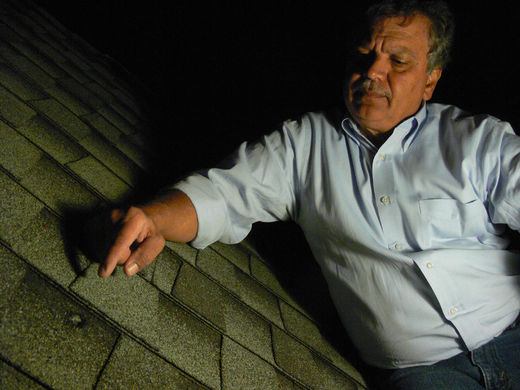
Two meteorites, that is, because the "rock" that fell on Lisa Webber's roof in Novato from last week's explosive fireball in the sky turns out to be a true meteorite after all.
Peter Jenniskens, the meteor scientist at the Seti Institute in Mountain View, said he first dismissed the one that hit Webber's house because its surface looked merely like a weathered chunk of granite and its outside wasn't black like most meteorites.
But he changed his mind, he said, because a chip from a second "rock" showed tiny specks of what looked like metal under his microscope - telltale signs of the violent collisions that typical meteors endure as they form in the asteroid belt and fall to Earth.
Now, a Sacramento man has reported finding the second meteorite in the Novato area on Monday.
Brien Cook, an amateur meteorite hunter, told The Chronicle he too had dismissed his "rock" at first. He said he stuck it in his pocket and threw it in his waste bucket at home.
"But next morning it didn't look quite right," he said, "so I cut a chip off it and looked inside and knew right away it was a meteorite."
The clue: barely visible specks of metal that couldn't exist in a granite rock.
Jenniskens said Webber, a UCSF nurse, has returned her meteorite to him and he will be sending samples of both objects to Professor Alan E. Rubin of the Institute of Geophysics and Planetary Physics at UCLA, a noted meteorite expert.
Rubin said judging from images he's seen of the two objects, they are probably stony meteorites called chondrites.
"They are igneous objects," he said, "and they contain sub-millimeter-sized grains of melted dust that formed during the early history of the solar system and have now become the asteroids we know."
Asteroids are the rocky objects - some tiny and some as big as dwarf planets - that exist in the asteroid belt and orbit the sun between the orbits of Mars and Jupiter.
"It's all incredible," Jenniskens said.
Comment: Well, you better believe it, cause it's happening all over the place.
Now, he said, he wants to find more meteorites so he can trace the line where they fell and calculate the meteor's orbit more precisely to determine where in the asteroid belt they originated.
Cook is now offering one chip of his meteorite on eBay. It weighs 6.6 grams - about two-tenths of an ounce - and objects like it normally sell for about $100 a gram, he said.
Pieces of both meteorites will soon wind up in Rubin's lab in Los Angeles for detailed analysis, Jenniskens said.



Reader Comments
to our Newsletter